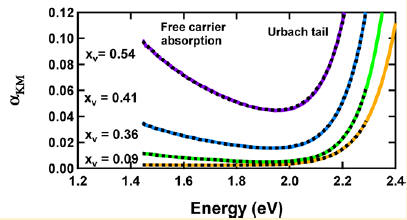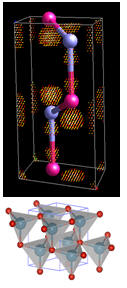- Home
-
Research Groups
Division Groups
- Artificial Photosynthesis
- Catalysis: Reactivity & Structure
- Electrochemical Energy Storage
- Electron- and Photo-Induced Processes for Molecular Energy Conversion
- Neutrino and Nuclear Chemistry
- Surface Electrochemistry and Electrocatalysis
Associated Groups
- Catalysis for Alternative Fuels Production
- Nanostructured Interfaces for Catalysis
- Structure and Dynamics of Applied Nanomaterials
- People
- Operations
- News
- Events

Artificial Photosynthesis
Design and characterization of BGNSCs for solar water splitting
 Nanorods of
GZNO (Ga(1-x)ZnxN(1-x)Ox) with a wide range of Zn contents (0 <
x < 0.60) were prepared with band gaps as low as 2.5 eV. For the first time,
quantitative fitting of the optical response below the band gap has been
achieved, allowing us to observe a response with an E-3 scaling
attributed to the scattering of free carriers from ionized defects. The
absorbance from the free carriers varies strongly with Zn content in GZNO,
suggesting that either the free carrier or impurity concentration is
strongly composition dependent. This optical signature can now be utilized
to guide the optimization of this semiconductor system, though further
spectroscopic experiments are planned to deconvolute the response from free
carriers and defects. Preliminary experiments find that the low-E absorbance
is suppressed by sample annealing.
Nanorods of
GZNO (Ga(1-x)ZnxN(1-x)Ox) with a wide range of Zn contents (0 <
x < 0.60) were prepared with band gaps as low as 2.5 eV. For the first time,
quantitative fitting of the optical response below the band gap has been
achieved, allowing us to observe a response with an E-3 scaling
attributed to the scattering of free carriers from ionized defects. The
absorbance from the free carriers varies strongly with Zn content in GZNO,
suggesting that either the free carrier or impurity concentration is
strongly composition dependent. This optical signature can now be utilized
to guide the optimization of this semiconductor system, though further
spectroscopic experiments are planned to deconvolute the response from free
carriers and defects. Preliminary experiments find that the low-E absorbance
is suppressed by sample annealing.
 Our earlier TEM
experiments have shown that hexagonal wurtzite GZNO can
contain abundant intergrowths with a similar composition but with a
different cubic zinc-blende type structure. Using high resolution
time-of-flight neutron diffraction data, we have been able to identify
signatures of these defects in the bulk of GZNO samples through the use of
Fourier difference maps to find minority (defect) sites influencing the
diffraction pattern. These defect sites (shown as yellow in map) occur at
two sets of sites related to the original cation (pink spheres) and anion
(grey spheres) site positions by vectors of (1/3, 2/3, 0) and (2/3, 1/3, 0)
in precisely the manner that is expected for stacking faults. Quantification
of the stacking faults as a function of Zn content is being carried out in
the neutron data presently, which should eventually enable the similar
quantification of defects using laboratory XRD data. This will enable
direct testing of the influence of synthesis conditions on defect
concentration, allowing the impact of defects on photoactivity to be
determined. The effect of these defects on the band gap of GZNO
semiconductors remains to be resolved.
Our earlier TEM
experiments have shown that hexagonal wurtzite GZNO can
contain abundant intergrowths with a similar composition but with a
different cubic zinc-blende type structure. Using high resolution
time-of-flight neutron diffraction data, we have been able to identify
signatures of these defects in the bulk of GZNO samples through the use of
Fourier difference maps to find minority (defect) sites influencing the
diffraction pattern. These defect sites (shown as yellow in map) occur at
two sets of sites related to the original cation (pink spheres) and anion
(grey spheres) site positions by vectors of (1/3, 2/3, 0) and (2/3, 1/3, 0)
in precisely the manner that is expected for stacking faults. Quantification
of the stacking faults as a function of Zn content is being carried out in
the neutron data presently, which should eventually enable the similar
quantification of defects using laboratory XRD data. This will enable
direct testing of the influence of synthesis conditions on defect
concentration, allowing the impact of defects on photoactivity to be
determined. The effect of these defects on the band gap of GZNO
semiconductors remains to be resolved.
Inorg. Chem. 2013, 52, 8389-8398, DOI: 10.1021/ic400011n




